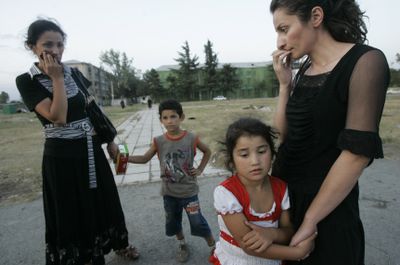Amid tales of violence, death toll still unclear
Georgians claim ties between Russians, militias

TKVIAVI, Georgia – Vladimir Otiashvili spent a day watching his son bleed to death.
He couldn’t rush Ioseb to the hospital because the same South Ossetian fighters who’d shot him in the stomach and arm were still on the streets of Tkviavi, looting houses and setting fires.
So Otiashvili sat by his son’s bedside, wept until it was over and then buried Ioseb under a mound of dirt in the garden.
More than a week after fighting ended between Georgia and Russia, exactly what happened on the battlefield during the five-day war and who was responsible for deaths like that of Ioseb Otiashvili remains unclear.
In villages such as Tkviavi, Georgian residents accuse South Ossetian irregulars of sweeping in after the Russian advance and wreaking havoc. Russian troops swept here after Aug. 8 after Georgia tried to seize control of the Russia-backed breakaway area of South Ossetia, just a few miles north of Tkviavi.
South Ossetian officials have accused Georgian forces of killing some 2,100 people during their offensive, a figure that was not supported by hospital officials in the region’s capital, Tskhinvali, and has been widely discredited.
Georgians say the casualty figures are much lower – 216 dead counted so far – and allege that the Russians allowed militias to run amok when they pushed Georgia’s military out of South Ossetia and drove deep into the country.
Researchers for Human Rights Watch, an international advocacy group, have found that villagers they interviewed consistently point to a link between the Russian military and Ossetian looters.
“What we have heard from the villagers is that they were definitely together,” said Ole Solvang, a consultant for the group who has gone on the fact-finding trips. “There seems to have been some kind of relationship.”
A top human rights official for the Georgian government, Sozar Subari, said he’s gotten conflicting reports of Russian troops protecting residents from Ossetian militias while at other locations allowing those same groups to kill and plunder.
“They are both true,” Subari said. “It depends on the Russian units involved.”
Subari said he didn’t know why different Russian ground commanders would behave so differently. The only certain thing, Subari said, is that in many Georgian villages “after the fighting there were robberies, killings and fires.”
Still, it was clear that a fair amount of looting had taken place in areas that had been firmly under Russian control. There were few cars on the road – many of them had been stolen, locals said.
In Karaleti, south of Tkviavi, a grocery store had been ransacked. Its shelves were empty, and spent bullet casings cluttered the floor. A beauty salon across the street was charred; villagers said South Ossetians threw Molotov cocktails into its windows.
Several houses had been shot at or hollowed out by fire.
“The Ossetians were driving around, and when they saw someone, they shot him,” said Givi Zanquriants, a farmer in Karaleti.
When asked how many times he actually saw that happen, Zanquriants motioned to a street corner and said he saw a man gunned down by Ossetians there on Aug. 10, but that was all.
Luiza Kapanadze, who lives in Tkviavi, said that on Aug. 13 a carload of Ossetians drove up and down the streets of her town. They stopped for a local man standing in front of his house and said hello in Georgian, she said. It was a test: When the man answered back in Georgian, they opened fire.
“A group of us carried his body away,” Kapanadze said, “and we buried him.”
And then, Kapanadze said, she fled to the woods and hid, waiting for the war to come to an end.